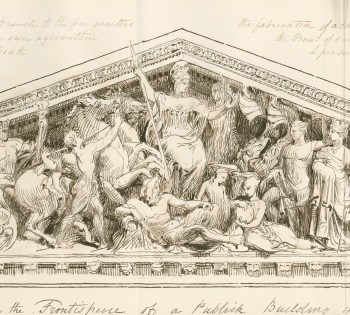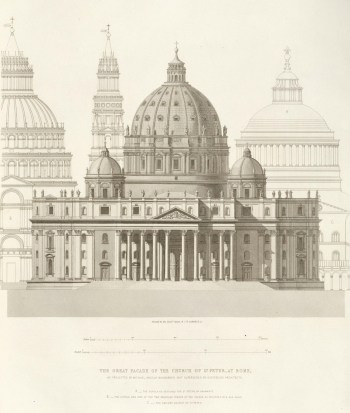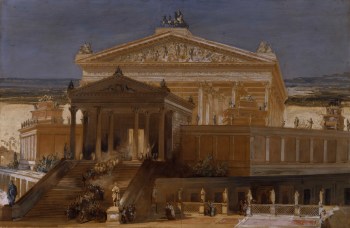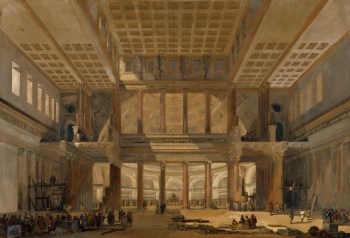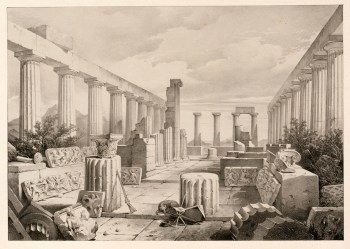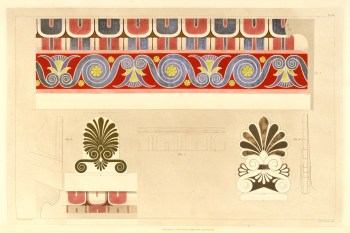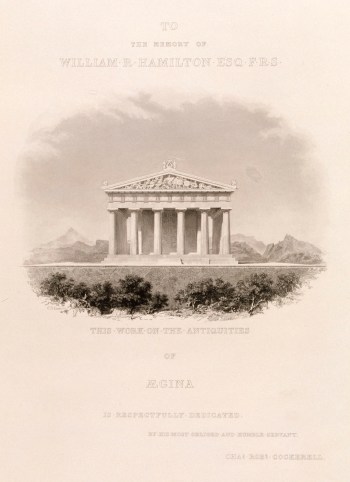C.R. Cockerell RA (1788 - 1863)
RA Collection: People and Organisations
Charles Robert Cockerell was born in London, the third of eleven children of the surveyor and architect Samuel Pepys Cockerell (1753-1827) and his wife Anne, nee Whetham. After attending Westminster School, he trained as an architect under his father before moving to work with the architect Robert Smirke.
The elder Cockerell was well-connected in artistic and architectural circles, and in 1808 organised for his son to undertake a tour of Wales and the West Country with the distinguished watercolourists Thomas and William Daniell. In 1810, the younger Cockerell embarked on a continental Grand Tour, again organised by his father.
Cockerell’s first destination was Constantinople; the wars between Britain and Napoleonic France meant that Italy and France were inaccessible to British travellers at the time. There, Cockerell met and befriended many international scholars and artists, including the poet Lord Byron. Over the next few years, Cockerell travelled through Greece and Asia Minor, making notable discoveries relating to Ancient Greek architecture, details of which he subsequently published. Napoleon’s defeat in 1814 opened the possibility of travel to Italy where he studied sculpture and paintings.
Despite wishing to pursue painting as a career instead of architecture, Cockerell returned to London in June 1817 and established himself as an architect. He was one of the founder members of the Travellers’ Club, intended as a place where foreign travellers could be entertained and receive hospitality from British members who they had met on the Grand Tour. The Travellers’ Club also provided Cockerell with an important source of potential patrons, and at least three fellow members commissioned him to redesign their country houses.
Drawing upon his first-hand knowledge of Greek architecture, Cockerell’s early designs included elaborate interiors inspired by discoveries from his travels. In 1822, he was chosen to design the Scottish National Monument on Calton Hill, Edinburgh. This was intended to be a full-scale replica of the Parthenon, but the project was abandoned after the construction of just twelve columns.
In 1828, Cockerell married Anna Rennie (1803-1872), the daughter of the civil engineer John Rennie; they went on to have ten children together. Many of Cockerell’s early architectural commissions were related to the banking and insurance industries in London. In the 1830s, he was involved in several projects for academic institutions, including the former University Library, Cambridge, the Ashmolean Museum and the Taylor Institution in Oxford. He also finished the design for the Fitzwilliam Museum, Cambridge, taking over from George Basevi in 1845. For the University Library (partially-completed) and the Ashmolean, Cockerell utilised stone of varying colours to evoke the polychromy of Greek architecture and design.
Elected as a full Academician in 1836, Cockerell became Professor of Architecture there in 1841, a post he retained for 15 years. He held many other public offices including Surveyor of St Paul’s Cathedral and architect to the Bank of England, and was the first professional President of the Royal Institute of British Architects from 1860. His international reputation was also reflected by various honours including the French Legion d’Honneur and being one of ten members of merit of the Accademia di San Luca in Rome.
Cockerell died in his home in Regent’s Park in 1863. His funeral was held in St Paul’s Cathedral, where he was buried in the crypt where a monument was later erected to him and his wife, designed by their son Frederick Pepys Cockerell.
RA Collections Decolonial Research Project - Extended Biography
Charles Robert Cockerell’s uncle, Charles Cockerell (1755-1837) was an East India Company official and banker and also an MP, whose firm was awarded compensation for several estates on Mauritius, as mortgagees, following the abolition of slavery in British colonies in 1834 (see Note 1). Charles Cockerell was also shown as owner of an estate in one case. Following the abolition of slavery, the Cockerell banking firm (Paxton, Cockerell & Traill) was active in recruiting indentured labourers from India for Mauritius.
Another uncle, John Cockerell, was a colonel in the East India Company army (see Note 1).
Charles Robert Cockerell’s brother Samuel Pepys Cockerell (1794-1869) was awarded compensation for 10 estates in Jamaica following abolition in 1834 (see Note 2). He was either a trustee or mortgagee of these estates.
Another brother, John Cockerell (1785-1869), a partner in the firm Paxton, Cockerell & Traill, was awarded extensive compensation for plantations in Mauritius, through his firm’s role as mortgagees (see Note 3).
For more information on this research project, please see https://www.royalacademy.org.uk/article/ra-collections-decolonial-research
Notes 1. https://www.ucl.ac.uk/lbs/person/view/2146011675 (accessed 1 July 2022) 2. https://www.ucl.ac.uk/lbs/person/view/43667 (accessed 1 July 2022) 3. https://www.ucl.ac.uk/lbs/person/view/2146008526 (accessed 1 July 2022)
Profile
Born: 28 April 1788 in London, England, United Kingdom
Died: 17 September 1863
Nationality: British
Elected ARA: 2 November 1829
Elected RA: 10 February 1836
Professor of Architecture: 1839 - 1859
Retired: 01 Dec 1862
Gender: Male
Preferred media: Architecture
Works by C.R. Cockerell in the RA Collection
33 results
-
![C.R. Cockerell RA, Some Account Of The Professional Life And Character Of The Late Professor C.R. Cockerell, R.A., Fellow, And Late President R.I.B.A. By Sydney Smirke, R.A., Fellow. Read at the Ordinary General Meeting of the Royal Institute of British Architects, Novembe]()
C.R. Cockerell RA
Idea for the frontispiece of a public building in England, 1843
Lithograph
-
![C.R. Cockerell RA, Competition design for the new Houses of Parliament: plan and elevation of the river front]()
C.R. Cockerell RA
Competition design for the new Houses of Parliament: plan and elevation of the river front, c.1835
Pencil, pen with black ink and grey wash
-
![Luigi Canina and C.R. Cockerell RA, The Great Facade of the Church of St Peter at Rome, as projected by Michael Angelo]()
Luigi Canina and C.R. Cockerell RA
The Great Facade of the Church of St Peter at Rome, as projected by Michael Angelo, 1857
Etching (on steel?)
-
![C.R. Cockerell RA, Temple of Aphaia, Aegina: view from the east]()
C.R. Cockerell RA
Temple of Aphaia, Aegina: view from the east, 1860
Etching and aquatint (on steel?)
-
![C.R. Cockerell RA, Baths of Caracalla, Rome: interior of the Tepidarium]()
C.R. Cockerell RA
Baths of Caracalla, Rome: interior of the Tepidarium
Watercolour
-
![C.R. Cockerell RA, Forum of Julius Caesar, Rome]()
C.R. Cockerell RA
Forum of Julius Caesar, Rome
Watercolour
-
![C.R. Cockerell RA, Imaginary view of the Temple of Jupiter Capitolinus, Rome]()
C.R. Cockerell RA
Imaginary view of the Temple of Jupiter Capitolinus, Rome
Watercolour
-
![C.R. Cockerell RA, Forum of Nerva, Rome]()
C.R. Cockerell RA
Forum of Nerva, Rome
Watercolour
-
![C.R. Cockerell RA, Imaginary sectional view of the interior of the Ulpian Basilica, Rome]()
C.R. Cockerell RA
Imaginary sectional view of the interior of the Ulpian Basilica, Rome
Watercolour
-
![C.R. Cockerell RA, Temple of Aphaia, Aegina: longitudinal section of platform and cave]()
C.R. Cockerell RA
Temple of Aphaia, Aegina: longitudinal section of platform and cave, 1860
Etching and engraving (on steel?)
-
![C.R. Cockerell RA, Temple of Apollo Epikourios, Bassae: view of interior]()
C.R. Cockerell RA
Temple of Apollo Epikourios, Bassae: view of interior, 1860
Etching and engraving (on steel?)
-
![C.R. Cockerell RA, Temple of Apollo Epikourios, Bassae: details of isolated column in interior]()
C.R. Cockerell RA
Temple of Apollo Epikourios, Bassae: details of isolated column in interior, 1860
Etching
-
![C.R. Cockerell RA, The Temples Of Jupiter Panhellenius At Ægina, And Of Apollo Epicurius At Bassæ Near Phigaleia In Arcadia. By C.R. Cockerell, Professor Of Architecture In The Royal Academy, Member Of The Institute Of British Architects, London; Honorary Doctor Of Civil L]()
C.R. Cockerell RA
Temple of Apollo Epikourios, Bassae: north front, 1860
Etching
-
![C.R. Cockerell RA, Temple of Apollo Epikourios, Bassae: view of the ruins from the north]()
C.R. Cockerell RA
Temple of Apollo Epikourios, Bassae: view of the ruins from the north, 1860
Chalk lithograph
-
![C.R. Cockerell RA, Temple of Minerva, Port of Aegina]()
C.R. Cockerell RA
Temple of Minerva, Port of Aegina, 1860
Etching and aquatint (on steel?)
-
![C.R. Cockerell RA, The Temples Of Jupiter Panhellenius At Ægina, And Of Apollo Epicurius At Bassæ Near Phigaleia In Arcadia. By C.R. Cockerell, Professor Of Architecture In The Royal Academy, Member Of The Institute Of British Architects, London; Honorary Doctor Of Civil L]()
C.R. Cockerell RA
Temple of Apollo Epikourios, Bassae: the interior after excavation, 1860
Chalk lithograph
-
![C.R. Cockerell RA, Temple of Apollo Epikourios, Bassae: view from Paulitza]()
C.R. Cockerell RA
Temple of Apollo Epikourios, Bassae: view from Paulitza, 1860
Etching
-
![C.R. Cockerell RA, Temple of Apollo Epikourios, Bassae: longitudinal section]()
C.R. Cockerell RA
Temple of Apollo Epikourios, Bassae: longitudinal section, 1860
Etching
-
![C.R. Cockerell RA, Temple of Aphaia, Aegina: The Fallen Laomedon]()
C.R. Cockerell RA
Temple of Aphaia, Aegina: The Fallen Laomedon, 1860
Etching and engraving (on steel?)
-
![C.R. Cockerell RA, The Temples Of Jupiter Panhellenius At Ægina, And Of Apollo Epicurius At Bassæ Near Phigaleia In Arcadia. By C.R. Cockerell, Professor Of Architecture In The Royal Academy, Member Of The Institute Of British Architects, London; Honorary Doctor Of Civil L]()
C.R. Cockerell RA
Temple of Aphaia, Aegina: tiling of the roof, 1860
Etching and aquatint
-
![C.R. Cockerell RA, The Temples Of Jupiter Panhellenius At Ægina, And Of Apollo Epicurius At Bassæ Near Phigaleia In Arcadia. By C.R. Cockerell, Professor Of Architecture In The Royal Academy, Member Of The Institute Of British Architects, London; Honorary Doctor Of Civil L]()
C.R. Cockerell RA
Temple of Aphaia, Aegina: details of painted and gilded ornament, 1860
Etching and aquatint with hand-colouring in watercolour, gouache and gold paint
-
![C.R. Cockerell RA, Temple of Aphaia, Aegina: exterior orders]()
C.R. Cockerell RA
Temple of Aphaia, Aegina: exterior orders, 1860
Etching and aquatint with hand-colouring
-
![C.R. Cockerell RA, Temple of Aphaia, Aegina: portion of the eastern front]()
C.R. Cockerell RA
Temple of Aphaia, Aegina: portion of the eastern front, 1860
Etching and aquatint with hand-colouring
-
![C.R. Cockerell RA, Temple of Aphaia, Aegina: western acroterium]()
C.R. Cockerell RA
Temple of Aphaia, Aegina: western acroterium, 1860
Etching and engraving
-
![C.R. Cockerell RA, Temple of Aphaia, Aegina]()
C.R. Cockerell RA
Temple of Aphaia, Aegina, 1860
Etching and engraving
-
![C.R. Cockerell RA, Temple of Jupiter Olympius, Agrigento: interior order of the cella]()
C.R. Cockerell RA
Temple of Jupiter Olympius, Agrigento: interior order of the cella, 1830
Etching
-
![C.R. Cockerell RA, Temple of Jupiter Olympius, Agrigento: transverse section]()
C.R. Cockerell RA
Temple of Jupiter Olympius, Agrigento: transverse section, 1830
Etching
-
![C.R. Cockerell RA, Temple of Jupiter Olympius, Agrigento: front elevation]()
C.R. Cockerell RA
Temple of Jupiter Olympius, Agrigento: front elevation, 1830
Etching
-
![C.R. Cockerell RA, The Temple Of Jupiter Olympius At Agrigentum, Commonly Called The Temple Of The Giants. By C.R. Cockerell, Architect, A.R.A. F.S.A.]()
C.R. Cockerell RA
Temple of Jupiter Olympius, Agrigento: fragments, 1830
Etching and engraving
-
![C.R. Cockerell RA, Sculpture on the West Front of Wells Cathedral]()
C.R. Cockerell RA
Sculpture on the West Front of Wells Cathedral, 1851 or earlier
Chalk lithograph
-
![C.R. Cockerell RA, West Front of Wells Cathedral]()
C.R. Cockerell RA
West Front of Wells Cathedral, 1851 or earlier
Steel-engraving
-
![C.R. Cockerell RA, The Professor's Dream]()
C.R. Cockerell RA
The Professor's Dream, 1848
Pencil, pen & grey ink and watercolour, with scratched highlights
-
![C.R. Cockerell RA, Temple of Apollo Epikourios, Bassae: section]()
C.R. Cockerell RA
Temple of Apollo Epikourios, Bassae: section, 1860
Etching
Works after C.R. Cockerell in the RA Collection
1 results
Works associated with C.R. Cockerell in the RA Collection
1 results
Associated books
8 results
-
C.R. Cockerell RA
The Temples Of Jupiter Panhellenius At Ægina, And Of Apollo Epicurius At Bassæ Near Phigaleia In Arcadia. By C.R. Cockerell, Professor Of Architecture In The Royal Academy, Member Of The Institute Of British Architects, London; Honorary Doctor Of Civil Law, Oxford; Member Of The Dilettanti Society; Associated Member Of The Institute Of France, And Chevalier Of The Legion Of Honour; Member Of The Academy Of St. Luke In Rome; Foreign Member Of The Academies Of Munich, Copenhagen, Geneva, Etc., Etc., Etc. To Which Is Added A Memoir Of The Systems Of Proportion Employed In The Original Design Of These Structures. By William Watkiss Lloyd. - London:: 1860.
05/731
-
C.R. Cockerell RA
The Temple Of Jupiter Olympius At Agrigentum, Commonly Called The Temple Of The Giants. By C.R. Cockerell, Architect, A.R.A. F.S.A. - [London:]: [1830]
05/377
-
C.R. Cockerell RA
Iconography Of The West Front Of Wells Cathedral, With An Appendix On The Sculptures Of Other Medieval Churches In England; By Charles Robert Cockerell, R.A., Professor Of Architecture In The Royal Academy Of London, D.C.L., Honorary Member Of The Institute Of France, Of The Academy Of St. Luke Of Rome, Of Those Of Munick And Berne, And Of Other Societies. - Oxford and London: [1851]
05/353
-
Sydney Smirke RA
Some Account Of The Professional Life And Character Of The Late Professor C.R. Cockerell, R.A., Fellow, And Late President R.I.B.A. By Sydney Smirke, R.A., Fellow. Read at the Ordinary General Meeting of the Royal Institute of British Architects, November 16, 1863). - [London?:: (1863.)
07/5164
Associated archives
13 results
-
W.B. Richmond, 10 York Street, Baker Street, to Thomas K. Richmond
[1 Jul 1858]
Item RI/1/2
-
C.R. Cockerell, to George Richmond
4 Nov [18]57
Item GRI/3/254
-
C.R. Cockerell, to [Joseph] Kay
27 May 1827
Item JU/11/379
-
C. R. Cockerell, Hampstead, London, to his "Dear Colleague" [John Gibson]
14 Dec 1856
Item GI/1/82
